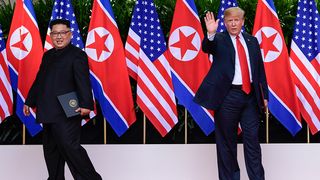In 1977, president Jimmy Carter was facing growing resistance from congress and the defence bureaucracy about a campaign pledge to draw down US military forces on the Korean peninsula.
“The essence of the question is: is our country committed on a permanent basis to keep troops in South Korea, even if they are not needed, to maintain the stability of that peninsula,” he said at the time.
After yesterday’s first meeting between a sitting US president and a North Korean leader, this very question may be relevant again.
As part of a broader peace deal, an eventual drawdown in US military forces on the peninsula could eventuate. Last month, President Donald Trump reportedly ordered Pentagon evaluations on what a withdrawal would look like.
Former White House adviser Steve Bannon talked of the need to exchange US troop presence on the peninsula for a freeze of North Korea’s nuclear program. A top South Korean presidential adviser suggested the same, before being forced to take his comments back.
The 28,500 US troops in South Korea form a large bulk of US ground forces in the Indo-Pacific.
They are largely prepared for “full-spectrum” conflict or the ability to confront an adversary across the full range of warfare, including artillery operations, electronic warfare and missile defence.
F-16 fighters, Army Black Hawk transport helicopters and a large contingent of Apache helicopters are stationed in South Korea. US special operations forces are also known to exercise frequently with their South Korean counterparts.
US forces in Korea are intended to perform a couple of functions. The first is a deterrent against North Korean aggression. They act as a “trip wire” or bulwark against any potential invasion from the North until reinforcements from Japan, Guam and the continental US arrive in the event of a conflict. They would also be an element of a “bolt from the blue” force if the US were to attack North Korea’s nuclear facilities.
But largely unsaid is the role these forces play in the US military posture in the Indo-Pacific. During Carter’s time, the US’s need for military forces in the Pacific was largely to deter North Korea, Soviet forces based in the Pacific and to maintain the status quo on Taiwan. Today, Beijing’s military is growing rapidly.
A staged drawdown of US forces from the peninsula is not necessarily bad for the US presence in the region, if it forms part of a larger peace agreement with North Korea that included verifiable arms control regarding their nuclear stockpile and missile inventory, as well as support for South Korea’s military forces. US troops and equipment in Korea could be shifted — to Japan or Guam — although both would be at a greater distance from critical North Korean nuclear and missile sites. The Pentagon may try to supplement this with increased naval patrols or selling advanced military equipment to Seoul.
Tokyo may welcome an increased US military presence on its soil. Japan wants complete disarmament of North Korea’s nuclear program. As this is unlikely, Japan may seek more presence and assurance from the Pentagon.
However, if a drawdown doesn’t occur in this context it may leave Washington in a weaker position. South Korea subsidises a significant chunk of US costs to station troops there (up to 50 per cent) and has agreed to pay for 92 per cent of a $US10.2 billion ($13.4bn) expansion to Washington’s largest overseas military base at Camp Humphreys. The US could end up paying more for any troops moved back home.
Seoul has also seen a re-emergence of domestic debate regarding the developing of its own nuclear weapons. The US military in South Korea help to prevent this.
And what if the US removes its forces from the peninsula and North Korea fails to honour its pledges? Washington will find itself with less leverage and potentially the same problem.






